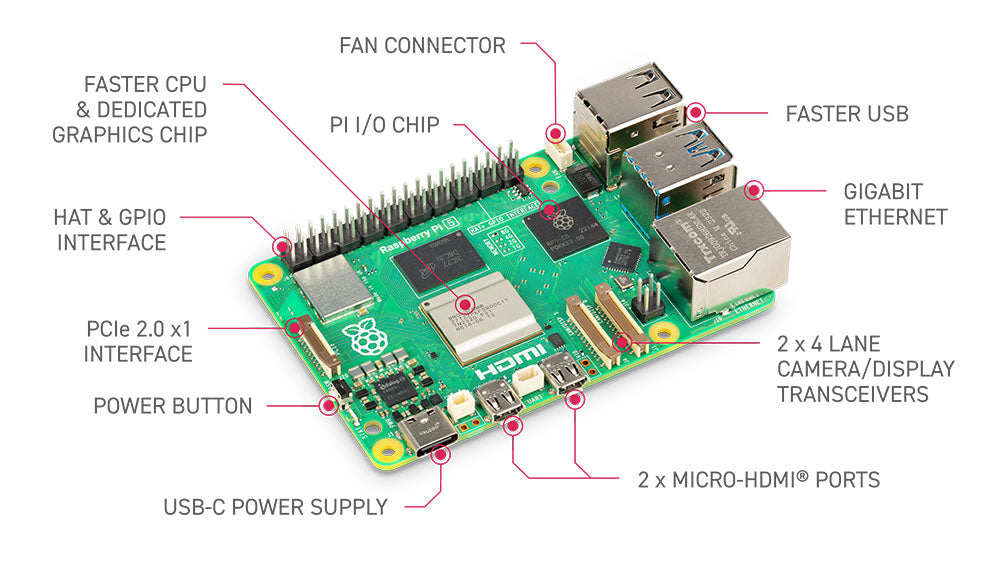With the launch of the Raspberry Pi 5, the latest version of everyone's favourite tiny and affordable quad-core computer, we aim to answer everyone's first question; "what are the differences between Raspberry Pi 4 & Raspberry Pi 5?"
The good news is that the Raspberry Pi 5 builds on the phenomenal success of Raspberry Pi 4 Model B and delivers a number of performance improvements and other specification upgrades. We are going to take a look at them, but for a quick comparison at a glance, we've presented the information in a table of all of the key features, improvements are highlighted in green.
The Differences Between Raspberry Pi 4 & Raspberry Pi 5:
Before we get too carried away with all of the new things and changes, it's important to take some time note key things that haven't changed. The Pi 5 general dimensions and layout are the same/similar to the Pi 4. Also, the GPIO pins on the Pi 5 are fully backwards compatible. This means that you can upgrade your existing Pi projects with the new Pi without having to rethink your whole peripheral connectivity/layout.
What's new?

In comparison with its predecessor, it delivers a 2-3x increase in CPU performance, via a a new 2.4GHz quad-core, 64-bit Arm Cortex-A76, with 512KB L2 cache and a 2MB shared L3 cache, and a significant uplift in GPU performance, via a VideoCore VII GPU. Other enhancements include improvements to camera, display, and USB interfacing. These interfacing improvements are delivered by the RP1 I/O controller chip, designed in-house at Raspberry Pi. For the first time, there is Raspberry Pi silicon on a flagship product!
The Raspberry Pi 5 is a quad-core computer that can drive 2 x 4k monitors, has 4GB or 8GB LPDDR4X-4267 SDRAM, Gigabit Ethernet, with PoE+ support, USB3.0, 2.4 GHz and 5.0 GHz 802.11ac Wi-Fi, Bluetooth 5.0, and more! It has all of the specs and the raw performance normally found on desktop PCs. At launch, it will be available in two versions, 4GB and 8GB.
The table below lists all of the features for both boards for a much easier comparison than a page full of words, new or improved features are highlighted in green. Check it out.
Raspberry Pi Key Features:
| Raspberry Pi 4 | Feature | Raspberry Pi 5 |
|---|---|---|
| Broadcom BCM2711, Quad core Cortex-A72 (ARM v8) 64-bit SoC @ 1.8GHz | CPU | 2.4GHz quad-core, 64-bit Arm Cortex-A76 CPU, with 512KB L2 caches and a 2MB shared L3 cache |
| Integrated into CPU | Video | VideoCore VII GPU |
| LPDDR4-3200 SDRAM | RAM | LPDDR4X-4267 SDRAM |
| 2.4 GHz and 5.0 GHz 802.11ac Wi-Fi | WiFi | 2.4 GHz and 5.0 GHz 802.11ac Wi-Fi |
| Bluetooth 5.0 / Bluetooth Low Energy (BLE) | Bluetooth | Bluetooth 5.0 / Bluetooth Low Energy (BLE) |
| Micro SD card slot, with support for high-speed | Storage | Micro SD card slot, with support for high-speed SDR104 mode |
| 2 x USB 3.0 ports, supporting simultaneous 5Gbps operation. | USB 3.0 | 2 x USB 3.0 ports, supporting simultaneous 5Gbps operation (improved). |
| 2 x USB 2.0 ports | USB 2.0 | 2 x USB 2.0 ports (improved) |
| Gigabit Ethernet, with PoE+ support (requires PoE+ HAT) | Ethernet | Gigabit Ethernet, with PoE+ support (requires PoE+ HAT) |
| 2 x micro-HDMI® ports (up to 4kp60 supported) | HDMI | 2 x micro-HDMI® ports (up to 4kp60 supported) |
| 2 x 2 lane MIPI camera/display transceivers | DSI/CSI | 2 x 4 lane MIPI camera/display transceivers |
| Bus | PCle | PCIe 2.0 x1 interface for fast peripherals |
| 5V/3A DC power | Power | 5V/5A DC power for more peripherals |
| Raspberry Pi standard 40-pin header | GPIO | Raspberry Pi standard 40-pin header |
| Time over Internet connection. | RTC | Real-Time Clock (RTC), powered from external battery |
| N/A | On/Off | On-board power button!! |
As shown in the above table, the Raspberry Pi 5 delivers substantial improvements over the Pi 4 Model B. It's got a dedicated GPU IC for improved video/graphics performance and the new CPU is 2-3 x faster than the previous one and even USB is considerably faster. After putting it through its paces, we have found that it is a significant step up from its predecessor.
Expand the accordion below for a full list of Raspberry Pi 5 specifications and general features.
Features:
- The Raspberry Pi 5 is the latest model of everyone's favourite single-board computer.
- Pi 5 sees significant upgrades and speed increases (2-3x in CPU performance) over its predecessor, the Raspberry Pi 4 Model B. A full feature comparison can be found here.
- The board is available in 4GB and 8GB versions.
- A pocket sized, dual-display, desktop computer, robot brain, smart home hub, media center, networked AI core, factory controller, NAS, and much more.
- Performance that rivals entry-level PC's at a fraction of the cost.
- Drop it straight into your old projects, it's the same general size and shape as its predecessors and the if features the same backwards compatible GPIO interface as its predecessors.
- The fanless, energy-efficient Raspberry Pi runs silently and uses far less power than other computers.
- It offers the perfect platform for learning/teaching; coding, Linux, IoT systems, streaming media, playing games, automated domestic and industrial applications, or your complete desktop solution and much much more.
- It is the first time the flagship product has features Raspberry Pi silicon, the RP1 I/O controller chip has been designed in-house at Raspberry Pi HQ.
- Raspberry Pi 5 builds on the phenomenal success of Raspberry Pi 4. In comparison with its predecessor, it delivers a 2-3x increase in CPU performance, and a significant uplift in GPU performance, alongside improvements to camera, display, and USB interfacing.
- Each board will include a marking on the upper side of the PCB to identify what memory density is fitted to a specific board.
- All boards now carry a unique serial number on the PCB.
- The Raspberry Pi 5 tech specs are;
- CPU: 2.4GHz quad-core, 64-bit Arm Cortex-A76, with 512KB L2 cache and a 2MB shared L3 cache.
- GPU: VideoCore VII GPU.
- RAM: LPDDR4X-4267 SDRAM.
- WiFi: 2.4 GHz and 5.0 GHz 802.11ac Wi-Fi.
- Bluetooth: Bluetooth 5.0 / Bluetooth Low Energy (BLE).
- Storage: Micro SD card slot, with support for high-speed SDR104 mode.
- USB 3.0: 2 x USB 3.0 ports, supporting simultaneous 5Gbps operation.
- USB 2.0: 2 x USB 3.0 ports.
- Ethernet: Gigabit Ethernet, with PoE+ support (requires PoE+ HAT).
- HDMI: 2 x micro-HDMI® ports (up to 4kp60 supported).
- DSI/CSI: 2 × 4 lane MIPI camera/display transceivers.
- PCle: PCIe 2.0 x1 interface for fast peripherals.
- Power: 5V/5A DC power.
- GPIO: Raspberry Pi standard 40-pin header (Backwards compatible).
- RTC: Real-Time Clock (RTC), powered from external battery.
- On/Off Switch: On-board power button!!
The Raspberry Pi 5 builds on what was already there and delivers a significant upgrade across the board. You can expect a smoother desktop experience and much more power on tap for any industrial applications.
Raspberry Pi 5 Lines from Kitronik:
Towards the end of the month, when stock becomes available, we will launch with the following lines. We will be adding more over time but the product pages below cover all of the essentials needed to upgrade your desktop.
- Raspberry Pi 5 4GB.
- Raspberry Pi 5 8GB.
- Raspberry Pi 5 Power supply.
- Raspberry Pi 5 Case.
- Raspberry Pi 5 Desktop Kit - Coming soon.
- Essential Raspberry Pi Accessories:
- Make sure you don't miss out on other news by signing up for our newsletter here.
©Kitronik Ltd – You may print this page & link to it, but must not copy the page or part thereof without Kitronik's prior written consent.






